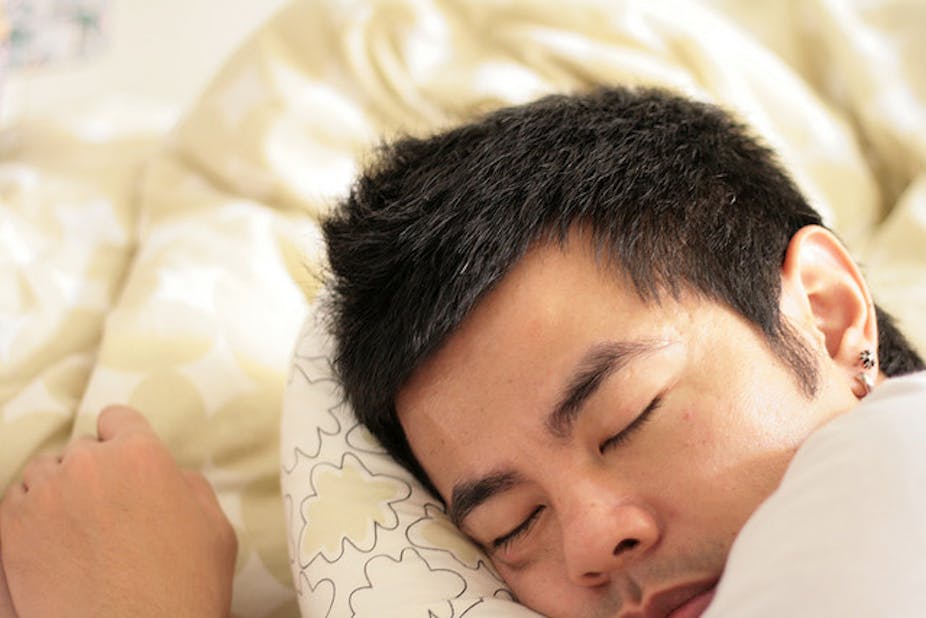Insomnia is far from a modern concept, with sleep remedies such as opioids, chamomile and valerian root recorded in the earliest existing medical writings. The word insomnia itself dates back to at least the 1620s.
But since the latter part of the twentieth century our sleep woes have worsened. Increasing economic prosperity and consumerism have increased work hours and led to more unpredictable shift work. And the widespread use of electric lights and caffeine keep us awake longer and longer.
Most doctors promote non-drug techniques such as sleep hygiene and cognitive-behavioural strategies before resorting to medication. But while techniques can be highly effective, they take time and effort to succeed, and they’re incredibly difficult to explain in a ten-minute GP consultation.
So how effective are prescription drugs at getting us to sleep on demand? And what risks do they come with?
Benzodiazepines
The most commonly prescribed sleeping tablets in Australia are benzodiazepines (BZDs). Temazepam (known under brand names Normison, Temaze, TemTabs, Euhypnos) is a short-acting BZD, which means that within six hours it has had its effect and been excreted from the body. Other BZDs used for insomnia with slightly longer actions times include oxazepam (brand names Alepam, Murelax, Serepax), nitrazepam (Alodorm, Mogadon) and diazepam (Antenex, Valium).
Despite their unsavoury reputation as “date-rape drugs” and drugs of addiction, BZDs have a recognisable role in medical practice for treating a handful of sleep disorders and as part of the treatment of severe anxiety disorders. They’re also used to manage agitation, alcohol withdrawal and acute situational crisis episodes.

But given the limited number of generally accepted scenarios for prescribing them, it’s hard to work out why temazepam and diazepam alone were written on around 3.1 million Australian PBS prescriptions in 2010 alone. This doesn’t include oxazepam or alprazolam, which have a limited availability on the PBS.
The sleep-related benefits of BZDs only last couple of months. Longer-term users experience the withdrawal rebound insomnia when they try to skip doses. Users often assume they’ll never be able to sleep without them and may even decide that long-term dependence is preferable to any risk of a withdrawal syndrome.
The BZD withdrawal period is notoriously long and difficult, requiring slow weaning for months to avoid symptoms such as nausea, cravings, headaches, severe anxiety, poor concentration, mood swings and even delirium.
For these reasons, the National Prescribing Service’s guidelines recommend only short-term use.
The pharmacology of BZDs is very complex, but it’s fair to say there can be unpredictable effects that differ from one person to another due to genetic and developmental differences which can’t be foreseen.
Z-drugs
During the 1990s, a newer group of sleep drugs came onto the market. These drugs targeted more specific receptor subtypes on the brain than BZDs, though they worked in much the same way. These drugs have become known as the “Z-drugs” and include zolpidem (Stilnox, Stildem, Somidem) and zopiclone (Imovane, Imrest).
But despite hopes Z-drugs may have had fewer problems and better efficacy than the BZDs, there seems to be little to choose between them.

Zolpidem has been associated with complex automatic behaviours such as sleep-driving, -walking, -eating and other purposeful behaviours. A patient of mine was found cooking pasta at 3am, after having taken Zolpidem and going to sleep. She was in a confused state and had no recollection of the event the next day. Other people have reported writing emails in their sleep.
These kinds of adverse events were being reported in Australia long before the publicity surrounding Heath Ledger’s tragic death brought it to wider public and regulatory awareness in early 2008.
But it’s important to note that these problems aren’t isolated to Z-drugs: similar reactions have been reported with every other sleep drug.
Over-the-counter and herbal products
Despite widespread confidence in valerian plant preparations, there remains little convincing high-level evidence that it improves sleep quality. Some studies have found valerian to have a positive effect, but the lack of agreement in published trials means no clear conclusion can be drawn.
Valerian is believed to act via the same receptor pathway as BZDs and Z-drugs, so it would be reasonable to suspect the longer-term issues of tolerance and poor efficacy would be similar. It can also cause liver toxicity, as can kava, another popular herbal recommendation for insomnia.

Chamomile is the other very commonly recommended sleep herb, but I could only find one fairly decent (though small) trial which was negative.
As for the rest of the complementary medicines, a systematic review published in 2010 gives little cause for optimism.
Melatonin
The one area of mildly positive news is melatonin and its derivatives. Melatonin is a hormone secreted by the pituitary gland and can be produced synthetically. It’s also found in some plants, including cherries.
Melatonin appears to be fairly effective in aiding sleep the short term, and it seems to be free of major side effects.
We have no information on whether it remains effective in the longer term. Melatonin is an important regulatory hormone that contributes to several other processes in the body, so it’s possible there could be unforeseen problems with long-term use.
Some newer melatonin-like molecules may be better suited to the sleep-related functions of melatonin, while having less effect on the other hormonal systems it activates.
A word of warning
We have been struggling with sleep as a species for so long, the use of anything other than very occasional doses of sleep medications – over-the-counter or prescription – needs to be strongly justified by compelling clinical need.
As clinicians, we do not do patients a favour by overseeing the exchange of one set of problems for a whole raft of others they didn’t sign up for. But this may mean giving up on the idea of sleep on demand.

